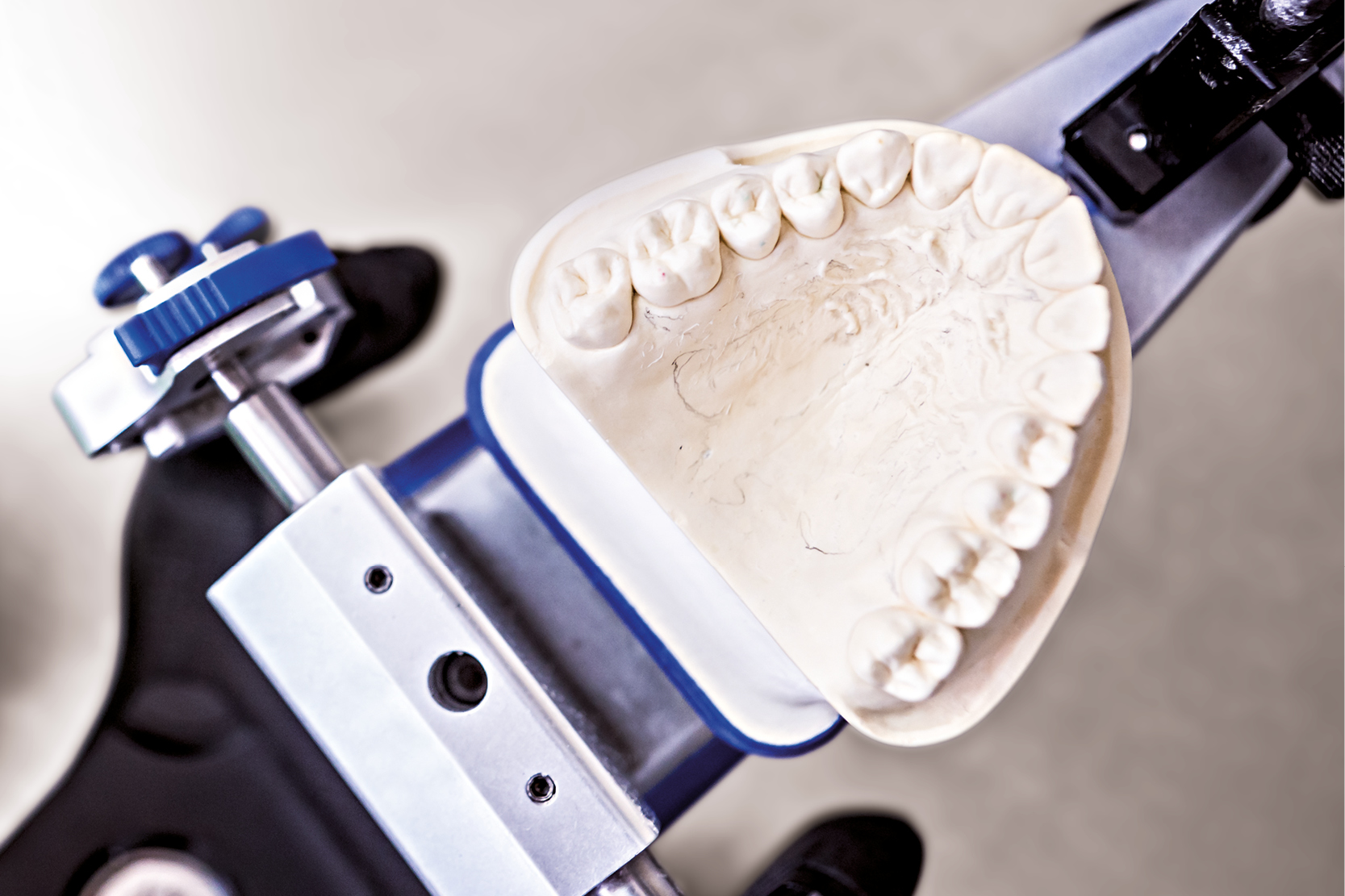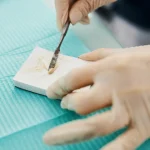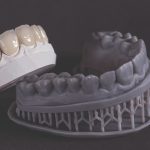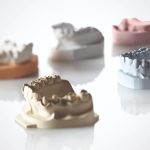
The production of a stone model is a key part of most procedures that result in a prosthesis or orthodontic device [1]. Stone models are positive reproductions of the patient’s intraoral anatomy. They are made from negative moulds, themselves obtained from intraoral impressions made using impression materials (alginates, polyvinylsiloxanes, etc.). They are then mounted in an articulator in order to produce the finished device [2]. Stone models are generally made from gypsum, a low-cost yet versatile material that is easy for dental technicians to work [3]. The technician uses the stone model to make a prosthetic framework that can be positioned in the patient’s mouth.
Stone models in dentistry
Depending on purpose, two types of stone model are used in modern dentistry [4]:
- Study or diagnostic models, which allow the dental practice to observe intraoral condition of the patient directly but extraorally. These models are used in initial aesthetic and functional evaluations to produce wax-ups simulating the dental reconstructions needed to restore correct physiological conditions.
- Working or master models, used to model and produce the prosthetic framework or the actual prosthesis that will be cemented in the patient’s mouth. Master models are also used to produce orthodontic devices.
To ensure that a stone model is indeed fit for purpose, it is essential to understand the ideal characteristics required of it. Essential properties include [3]:
- Accuracy and precision
- Dimensional stability
- Mechanical strength
- Resistance to wear
- Compatibility with impression materials
- Model construction time
- Colour
- Operator safety
- Low cost
Accuracy and precision
Accuracy and precision are essential properties of any model that needs to reproduce a patient’s intraoral condition faithfully and without distortion [5, 6]. Whenever a fixed prosthesis like a bridge or a crown is required, it must fit its abutments as accurately as possible [1].
The stone model must therefore reproduce every little detail of the dental preparations accurately and precisely. Precision is especially important at the margin of the preparation, which is always the most critical point in any prosthetic rehabilitation [7]. Impression material in this area may be too thin or even completely absent and the presence of bubbles of saliva or other fluids may lead to irregularity in surfaces, making the work of the dental technician more difficult [8].
Dimensional stability
Dimensional stability is needed to preserve the characteristics of accuracy and precision over time, after the initial setting reaction [9]. Once cast, the stone model needs to remain stable over time without absorbing water molecules in humid ambient conditions and expanding, or contracting through liquid loss [10, 11].
Only in this way can the dental technician rely on the model to prepare or modify devices over time and give the dentist the time needed to test the device in the patient’s mouth.
Mechanical strength
Mechanical strength and resistance to wear are two other important properties for stone models since the devices produced using them are inserted and extracted repeatedly by the technician during the production process [12]. Models therefore need sufficient wear resistance to resist dimensional alterations.
Compatibility with impression materials is essential if accurate and precise models are to be produced. Though modern impression materials are more or less all compatible with gypsum, different stones crystallise in contact with impression materials in different ways, and performance may also vary depending on the formula of the gypsum used [13].
This is because gypsum is hydrophilic while impression materials may be either hydrophilic of hydrophobic. This determines different angles of contact as the gypsum flows over the impression material, potentially leading to differences between finished models obtained from hydrophobic materials and those obtained from hydrophilic ones [14].
In addition, with hydrophilic materials, water molecules are exchanged between the gypsum and the impression,causing initial expansion and subsequent contraction during the setting reaction. This may lead to variation in production times and in the mechanical strength of the model [15].
Stone model construction time and colour
Model construction time influences the time required to produce the prosthesis and the level of detail in the positive model [16]. Anything from a few minutes to a few hours may be needed to produce a stone model that the dental technician can work with. The literature, however, shows that longer casting times generally lead to more detailed models [9, 16].
Colour is another aspect that may influence the production of a device [17]. This is especially true in the case of translucent prostheses, which always cause problems for the technician, especially when the colour of the abutments is radically different. Additives can be mixed into the gypsum during the mixing process to produce coloured models or different shades, thereby helping the technician in the production of the prosthesis.
Operator safety
Turning to operator safety and low cost, the vast majority of products on the market today satisfy these requirements. It must never be forgotten, however, that operator safety also demands correct disinfection of impression materials [18, 19].
This is important not only to prevent cross-contamination between the dental practice and the laboratory, but also because disinfection can have a significant impact on the compatibility of the impression material and on the reproduction of the details found in the stone model [20].
Professional products for stone models
To conclude, we can affirm that stone models are essential both to the dental practice and to the dental laboratory in the production of prostheses and orthodontic devices. Today, though digital technologies permit completely virtual work flows that eliminate the need for physical models, these technologies are only applicable in certain clinical cases.
The production of as stone model with the right properties remains the “gold standard” technique for complex rehabilitations, as digitally produced models (3D printed or milled) cannot always achieve the same results [21, 22].
Zhermack supplies a range of high performance products for the production of stone models. Zhermack’s Elite Dental Stones range boasts low expansion, even after 48 hours, and satisfies the needs of dental technicians in the production of fixed and removable prostheses. Types 3 and 4 from the Elite Dental Stones range offer different specific solutions for the production of antagonist or diagnostic models and for the preparation of master models.
Bibliography
[1] Shillinburg HT, et al. Fundamentals of fixed prosthodontics. Quintessence Publishing Company, 1997 n.d.
[2] The Glossary of Prosthodontic Terms: Ninth Edition. J Prosthet Dent 2017;117: e1-e105 n.d.
[3] Breschi L, et al. Materiali e tecnologie odontostomatologiche. (2011): 95-117. n.d.
[4] Seong W, Polack MA, Delima LF, Lee J. Technique to Maintain the Correct Spatial Orientation of the Maxillary Diagnostic Cast to that of the Master Cast in a Full-Mouth Rehabilitation Case. J Prosthodont Off J Am Coll Prosthodont 2021;30:271–5. https://doi.org/10.1111/jopr.13300.
[5] Potran M, Štrbac B, Puškar T, Hadžistević M, Hodolič J, Trifković B. Measurement of the accuracy of dental working casts using a coordinate measuring machine. Vojnosanit Pregl 2016;73:895–903. https://doi.org/10.2298/VSP150105089P.
[6] Millstein PL. Determining the accuracy of gypsum casts made from type IV dental stone. J Oral Rehabil 1992;19:239–43. https://doi.org/10.1111/j.1365-2842.1992.tb01098.x.
[7] Nesse H, Ulstein DMÅ, Vaage MM, Øilo M. Internal and marginal fit of cobalt-chromium fixed dental prostheses fabricated with 3 different techniques. J Prosthet Dent 2015;114:686–92. https://doi.org/10.1016/j.prosdent.2015.05.007.
[8] Laufer BZ, Baharav H, Ganor Y, Cardash HS. The effect of marginal thickness on the distortion of different impression materials. J Prosthet Dent 1996;76:466–71. https://doi.org/10.1016/s0022-3913(96)90002-5.
[9] Sayed ME, Gangadharappa P. Three-dimensional evaluation of extended pour alginate impression materials following variable storage time intervals and conditions. Indian J Dent Res Off Publ Indian Soc Dent Res 2018;29:477–86. https://doi.org/10.4103/ijdr.IJDR_426_17.
[10] Tian B, Cohen MD. Does gypsum formation during sulfate attack on concrete lead to expansion? Cem Concr Res 2000;30:117–23. https://doi.org/10.1016/S0008-8846(99)00211-2.
[11] Yang X, Zhu G, Chen L. [Dimensional accuracy of dental gypsum casts after immersion in stable chlorine dioxide disinfectant]. Zhejiang Xue Xue Bao Yi Xue Ban J Zhejiang Univ Med Sci 2010;39:318–21. https://doi.org/10.3785/j.issn.1008-9292.2010.03.017.
[12] Duke P, Moore BK, Haug SP, Andres CJ. Study of the physical properties of type IV gypsum, resin-containing, and epoxy die materials. J Prosthet Dent 2000;83:466–73. https://doi.org/10.1016/s0022-3913(00)70043-6.
[13] Kioleoglou I, Pissiotis A, Konstantinos M. Accuracy of fit of implant-supported bars fabricated on definitive casts made by different dental stones. J Clin Exp Dent 2018;10:e252–63. https://doi.org/10.4317/jced.54603.
[14] Butta R, Tredwin CJ, Nesbit M, Moles DR. Type IV gypsum compatibility with five addition-reaction silicone impression materials. J Prosthet Dent 2005;93:540–4. https://doi.org/10.1016/j.prosdent.2005.04.006.
[15] Ibrahim AA, Alhajj MN, Khalifa N, Gilada MW. Does 6 Hours of Contact With Alginate Impression Material Affect Dental Cast Properties? Compend Contin Educ Dent Jamesburg NJ 1995 2017;38:e1–4.
[16] Sharif RA, Abdelaziz KM, Alshahrani NM, Almutairi FS, Alaseri MA, Abouzeid HL, et al. The accuracy of gypsum casts obtained from the disinfected extended-pour alginate impressions through prolonged storage times. BMC Oral Health 2021;21:296. https://doi.org/10.1186/s12903-021-01649-2.
[17] Tan F-B, Wang C, Dai H-W, Fan Y-B, Song J-L. Accuracy and reproducibility of 3D digital tooth preparations made by gypsum materials of various colors. J Adv Prosthodont 2018;10:8–17. https://doi.org/10.4047/jap.2018.10.1.8.
[18] Matalon S, Eini A, Gorfil C, Ben-Amar A, Slutzky H. Do dental impression materials play a role in cross contamination? Quintessence Int Berl Ger 1985 2011;42:e124-130.
[19] Owen CP, Goolam R. Disinfection of impression materials to prevent viral cross contamination: a review and a protocol. Int J Prosthodont 1993;6:480–94.
[20] King BB, Norling BK, Seals R. Gypsum compatibility of antimicrobial alginates after spray disinfection. J Prosthodont Off J Am Coll Prosthodont 1994;3:219–27. https://doi.org/10.1111/j.1532-849x.1994.tb00159.x.
[21] Kim S-Y, Lee S-H, Cho S-K, Jeong C-M, Jeon Y-C, Yun M-J, et al. Comparison of the accuracy of digitally fabricated polyurethane model and conventional gypsum model. J Adv Prosthodont 2014;6:1–7. https://doi.org/10.4047/jap.2014.6.1.1.
[22] Etemad-Shahidi Y, Qallandar OB, Evenden J, Alifui-Segbaya F, Ahmed KE. Accuracy of 3-Dimensionally Printed Full-Arch Dental Models: A Systematic Review. J Clin Med 2020;9:E3357. https://doi.org/10.3390/jcm9103357.
Do you want more information on Zhermack Dental products and solutions?
Contact us




 Zhermack SpA has been one of the most important producers and international distributors of alginates, gypsums and silicone compounds for the dental sector for over 40 years. It has also developed solutions for the industrial and wellbeing sectors.
Zhermack SpA - Via Bovazecchino, 100 - 45021 Badia Polesine (RO), Italy.
Zhermack SpA has been one of the most important producers and international distributors of alginates, gypsums and silicone compounds for the dental sector for over 40 years. It has also developed solutions for the industrial and wellbeing sectors.
Zhermack SpA - Via Bovazecchino, 100 - 45021 Badia Polesine (RO), Italy.


